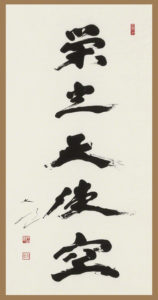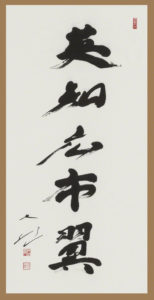Ikeda Sensei sent the following message to the Fifth Soka Gakkai Headquarters Leaders Meeting Toward Our Centennial, commemorating the 91st anniversary of the Soka Gakkai’s founding, held at the Toda Memorial Auditorium in Sugamo, Tokyo, on Nov. 18, 2021. Nov. 18 also marked the publication of a newly revised Japanese edition of the Nichiren Daishonin Gosho zenshu (Collected Writings of Nichiren Daishonin) and the full-fledged start of the new Soka Gakkai women’s division in Japan, combining the previous young women’s and women’s divisions. At the meeting, Soka Gakkai President Minoru Harada also introduced next year’s theme, the Year of Youth and Dynamic Progress. This message was originally published in the Nov. 19, 2021, issue of the Soka Gakkai’s daily newspaper, Seikyo Shimbun.
In this year of many difficult challenges, our Soka family around the globe has striven tirelessly to spread the Mystic Law in the spirit of “regarding both suffering and joy as facts of life” (see “Happiness in This World,” The Writings of Nichiren Daishonin, vol. 1, p. 681). With wonderful victories achieved again through our solid unity, we today celebrate Soka Gakkai Founding Day and mark founding president Tsunesaburo Makiguchi’s death in prison for his beliefs. I offer you my heartfelt congratulations and thanks.
Nichiren Daishonin, the Buddha of the Latter Day of the Law, writes, “The wise [person] who works to propagate the five characters of the Mystic Law,[1] no matter how lowly [their] station, should be looked upon as a manifestation of Bodhisattva Superior Practices, or perhaps as an envoy of Shakyamuni Thus Come One” (“Those Initially Aspiring to the Way,” WND-1, 880). These words attest to your greatness and to the immense good fortune and benefit you will receive! I wish to convey my deepest respect and appreciation for everyone’s unstinting, noble efforts, especially those of the Many Treasures Group.
Today, as an expression of my gratitude and admiration for our members, I would like to share with you three calligraphies I inscribed.[2] The first is “The Treasure of the Teachings of Nichiren Buddhism” to celebrate the publication of the new edition of the Nichiren Daishonin Gosho zenshu (Collected Writings of Nichiren Daishonin).[3]

“The Treasure of the Teaching of Nichiren Buddhism”
In his foreword to the original Soka Gakkai edition of the Nichiren Daishonin Gosho zenshu published in 1952, commemorating the landmark 700th anniversary of Nichiren’s establishment of his teaching,[4] second Soka Gakkai President Josei Toda promised to do his best to undertake future revisions, if necessary. Inheriting my mentor’s wish, I have actualized this with the assistance of outstanding, dedicated disciples. I feel there is no more fitting way to repay Mr. Toda than publishing this new, revised edition of the Gosho zenshu in our founding month and the year of the 800th anniversary of the Daishonin’s birth.[5]
The teachings of Nichiren are a treasure of our lives as Soka Gakkai members; at the same time, they are a precious treasure for all humankind.
Even amid the restriction imposed by the coronavirus pandemic, our members around the world, with creativity and ingenuity, have continued to make unflagging efforts to study the Daishonin’s teachings. Their seeking spirit is truly noble.
There has never been a greater need for a sound, hope-filled philosophy that can guide the way to realizing a new global civilization. Now is the time for us to share the universal, life-affirming principles of Nichiren Buddhism and build a solidarity of global citizens on an even broader scale.
The second calligraphic work I wish to share is “The Brilliant Skies of Heavenly Emissaries” to celebrate the young women’s division merging with the women’s division in Japan today.[6]

“The Brilliant Skies of Heavenly Emissaries”
I am certain that my mentor, who urged young women “Make study your foundation!” is looking on with a warm smile as on this day—the Soka Gakkai’s anniversary—the women’s division in Japan make a fresh start coinciding with the publication of the new edition of Nichiren’s writings.
Mr. Toda’s most cherished wish was that every young woman in the Soka Gakkai become happy without fail.
The Daishonin writes, “The enlightenment of women is expounded as a model [for the enlightenment of all living beings]” (“The Sutra of True Requital,” WND-1, 930).
I call on you, the women of Soka, to continue chanting Nam-myoho-renge-kyo through all, no matter what happens. May each one of you without exception, as heavenly emissaries of happiness and peace, lead lives brimming with “the greatest of all joys” (see The Record of the Orally Transmitted Teachings, p. 212). I hope you will always strive together with a sense of enjoyment, warm camaraderie and self-confidence.
While treasuring your families, friends and loved ones, please also continue reaching out with an openhearted spirit to other like-minded people committed to working for human happiness and peace. And joyfully help guide many others to soar in the brilliant skies of unsurpassed honor.
Lastly, as we prepare to embark on the “Year of Youth and Dynamic Progress” (in 2022), I wish to share with you a calligraphy reading “The Wings of Wisdom for Kosen-rufu.”

“The Wings of Wisdom for Kosen-rufu”
The phenomena of the universe are in constant flux, never still for an instant. The Mystic Law is the ultimate principle for moving everything in a positive direction. The great Buddhism of human revolution that we practice teaches us to activate this transformative power in our own lives and urge others to do the same. It enables us to overcome any apathy or inertia in our hearts “day by day and month after month” (see “On Persecutions Befalling the Sage,” WND-1, 997), make dynamic strides in our lives and create a better world.
The lay nun Sennichi was a sincere disciple of resolute faith who brushed aside criticism in the spirit of “Let them say what they will” (see “The Embankments of Faith,” WND-1, 626), while supporting fellow practitioners and fostering successors. In a letter to her, the Daishonin writes: “[The Lotus Sutra] is superior to all other sutras. It is like the lion king, the monarch of all the creatures that run on the ground, and like the eagle, the king of all the creatures that fly in the sky” (“The Sutra of True Requital,” WND-1, 929–30).
Next year marks the 70th anniversary of the February Campaign,[7] in which I led the way to dynamic progress in our movement for kosen-rufu to repay my gratitude to my mentor. Let’s make our courageous lion’s roar of the oneness of mentor and disciple for justice and humanity resound in our troubled world. Let us spread wide our wings of compassion and wisdom to embrace and encourage our suffering friends, and soar in the sky with regal majesty and pride!
Seventy years ago, when we completed the first Soka Gakkai edition of the Gosho zenshu through the efforts of mentor and disciples, Mr. Toda wrote a poem in the copy he presented to me. I would like to close my message today by sharing it with my most precious and beloved youth, and indeed all our members who continue to strive with youthful hearts:
Brimming with the power
to move mountains,
spur your youthful self on
to challenge and strive
on the path of the Mystic Law.
Let our Soka movement advance triumphantly for the sake of Japan, the world and the future!
References
- Myoho-renge-kyo is written with five Chinese characters, while Nam-myoho-renge-kyo is written with seven (nam, or namu, being comprised of two characters). Nichiren Daishonin often uses Myoho-renge-kyo synonymously with Nam-myoho-renge-kyo in his writings. ↩︎
- The calligraphic works were shown to the audience. ↩︎
- The new edition was released on Nov. 18, 2021. ↩︎
- According to the traditional Japanese way of counting. Nichiren established his teaching on April 28, 1253. ↩︎
- According to the traditional Japanese way of counting. The Daishonin was born on Feb. 16, 1222. ↩︎
- In April 2021, it was announced that the women’s division and young women’s division in Japan would make a fresh start by joining together in a new women’s division (Jpn josei-bu). As the first step, from May 3, the Japanese name for the women’s division changed from fujin-bu to josei-bu, with the English translation remaining unchanged. As the second step, from Nov. 18, the young women’s division officially merged with the new women’s division. This change applies only to the organization in Japan. ↩︎
- February Campaign: In February 1952, Ikeda Sensei, then adviser to Tokyo’s Kamata Chapter, initiated a dynamic propagation campaign. Together with the Kamata members, he broke through the previous monthly record of some 100 new member households by introducing Nichiren Buddhism to 201 new member households. ↩︎
You are reading {{ meterCount }} of {{ meterMax }} free premium articles

